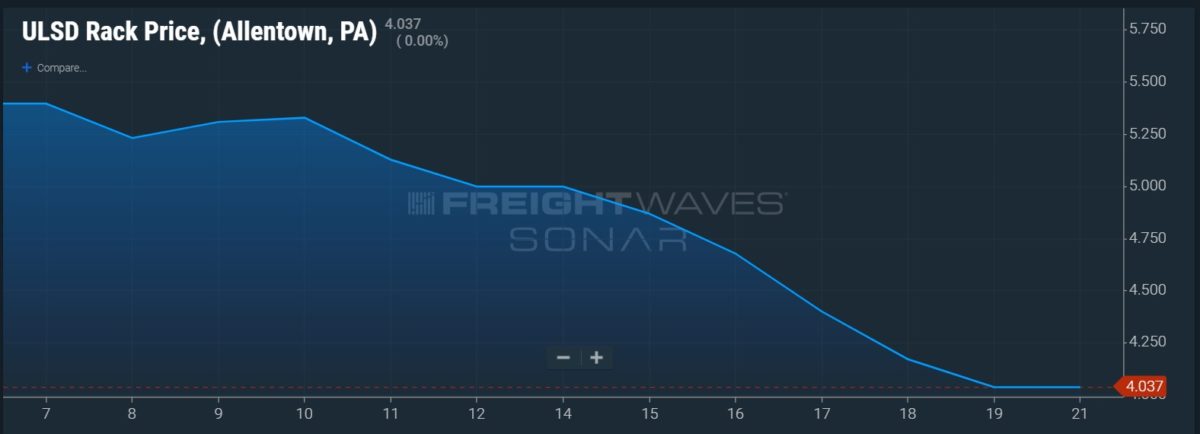While the Department of Energy/Energy Information Administration average weekly retail price for diesel declined by a sizable but restrained 8 cents a gallon, there are other signs that the tremendous upward pressure on prices may be easing.
The EIA price released Monday, which serves as the benchmark for most fuel surcharges, was $5.233 a gallon, down from $5.313. It’s still above the $5 level, and the price was below that marker as recently as late September and early October. So while the decline is a relief to truck drivers, it’s still only down 10.8 cents a gallon from the recent high of $5.341, set on Oct. 24.
The 8-cent decline is the largest one-week downward move since an 8.2-cent drop Aug. 15.
But the pressure for further price declines is building, starting with the foundation for what ultimately gets posted at the pump: the price of ultra low sulfur diesel on the CME commodity exchange. It declined 2.08 cents Monday to settle at $3.4973 a gallon. That is the lowest settlement since Oct. 3.
That settlement is significant in several other ways. The current price is below several rolling averages, such as the average of ULSD since July 1 through Monday and from July 1 until that Oct. 3 recent low. When prices break under rolling averages, it is seen as a bearish sign.
With the decline Monday, the price of ULSD on CME has now dropped 11 of the prior 12 trading days, shedding just slightly more than 50 cents a gallon during that time.
A great deal of attention in the U.S. diesel market has been focused on the East Coast, where the DOE/EIA reported a New England average retail price of $5.963 a gallon Monday, a drop of 9.7 cents from the prior week. The price in the EIA-designated Central Atlantic region was down a little less, 4.7 cents a gallon, and at $5.941 a gallon, it’s now just under the New England price.
That the East Coast market was tight could be seen primarily in the spot market spread between physical diesel traded in New York Harbor for prompt delivery and the price of ULSD on CME. It got as high as $1.20 on Nov. 9 and 10, according to data from DTN Energy. By Monday, with an influx of diesel imports into the East Coast, that spread had fallen to 9.25 cents, according to DTN.
Energy economist Philip Verleger, in his widely read Monday report, declared that “Arbitrage Works.” The ability to buy diesel elsewhere in the world and ship it to the U.S. East Coast at the region’s elevated prices has led to numerous cargoes headed on that route.
“Ten days ago, something apparently went amiss,” Verleger wrote. “Indeed, for four consecutive days, the difference between the cash and futures price was $1.20 per gallon.” With that squeeze having run its course, broken in part by the influx of new supplies, the price of physical diesel in the spot market headed down, with wholesale prices declining as well.
Although retail prices can lag movements in futures prices by many days, that is not the case with wholesale prices. For example, the wholesale price of diesel in the Allentown, Pennsylvania, area, based on SONAR data in the ULSDR.ABE series, stood Monday at $4.037 a gallon. On Nov. 3, it was $5.396.

Oil markets are declining in general because of a series of news developments that all point to lower levels of demand. The continuing lockdowns in China are often cited as a key bearish sentiment, as well as fears of a broader recession. There are reports that European refiners are now dealing with an excessive amount of crude, and physical spreads in the crude market are reflecting that.
But there are other indicators in the market that while oil is slumping in general, and the East Coast diesel squeeze might be easing, diesel remains the strongest part of the barrel. Its spread against Brent on the CME has risen about 10 cents a gallon in the past week.
There also is the issue of diesel inventories. While last week’s EIA inventory report showed small but significant increases in some inventory numbers, the market is not signaling a big change in its perception of tight markets.
That can be seen in the 12-month spread on the ULSD market. When inventories are tight, the first month that trades on an exchange — in the case of ULSD, December — is higher than the next month and the month after that and so on, a structure known as backwardation.
If the backwardation is declining, it’s a sign that the market believes inventories are growing. The 12-month backwardation Monday at about 67 cents was in the range of where it has been recently, signaling the market is not seeing a radical change in the tight inventory situation, except on the U.S. East Coast.
More articles by John Kingston
2 fuel retailer groups have a message: There will be enough diesel
Winter’s coming and that could have major impacts on already soaring diesel market
ELDs coming to California intrastate trucking in 2024, trailing rest of the US








Jackie Fuller
As well as the way, do possess to the application developers along with a mobile record? How rigid is the ROI that can go with these stock offerings? Windows Recuperation Surroundings been specifically up-to-date.